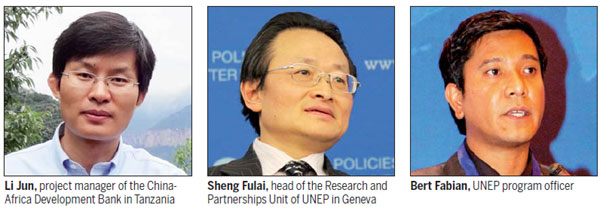
|
Alex Awiti, director of the East African Institute of The Aga Khan University in Nairobi. Photos Provided to China Daily |

Industrial transfer has to produce economic and social benefits, but possibilities are limited
A bottle of water stands on the desk in an office in the Ethiopian capital, Addis Ababa. The water is so clear that it is barely imaginable that a short while ago it was running through a river into which flows all the waste water from a local tannery.
The fact that the water, in an office of the Sululta environmental authority, is regarded as the purest river water in the region is a feather in the cap of the tannery, proud that its processed waste water has met the requirements of local environmental regulations and is harmless to the environment.
But making that happen was no easy task, says He Mingliang, president of China-Africa Overseas Leather Products SC in Sululta, who says local people are keenly aware of environmental protection and are even willing to forfeit economic growth if it means having clean water.
"So we have worked hard to improve our waste water processing procedures since we opened the tannery in 2010. It's one of the biggest challenges I have had since I entered this industry 29 years ago."
Paying heed to the environment is expensive, time consuming and sometimes full of ambiguities because of indifferent law enforcement, but it is the only way to survive in the long run, He says.
His assessment boils down to this: If Chinese investors in Africa do not handle environmental issues correctly, their businesses are likely to be deemed harmful and be short lived.
"We are improving conditions in China, so it's logical that we should be doing the same in Africa," he says. "With nearly four years' experience, we aim to set the tone for the tanning industry in Ethiopia in environmental protection."
China has paid a high environmental price for its economic growth over the past 30 years, and unprecedented levels of air pollution in big cities in the past two years have only served to increase alarm over damage caused. Government, business and individuals are now deadly earnest as they try to do something about it by embracing green solutions.
Bert Fabian, program officer of the Division of Technology, Industry and Economics at the United Nations Environment Programme, says China's phenomenal economic growth has driven dizzying rates of urbanization, driving up demand for energy to power factories and homes and putting tens of millions of cars on the road.
"This rapid growth in cities and vehicles and huge energy demand may have overwhelmed national and city authorities to effectively regulate and address environmental problems, particularly, air pollution," he says. "As expected, the environment and public health bore the brunt of air pollution."
Now that sustainable development and the green economy have been widely adopted as articles of faith by many countries that want to achieve economic, social and environmental balance, the UNEP is helping those that want to put them into practice.
"Such policies have to be based on a comprehensive and careful assessment of the problem," Fabian says.
"For air pollution, developing stricter standards to regulate emissions from vehicles and industries is a must, and adopting the best available technologies, especially in key industries and vehicles, is critical in reducing air pollution. Better urban planning alongside active promotion of public transport and non-motorized transport are also important."
A study by the World Bank and the Development Research Center of the State Council has estimated that air pollution in China can cost between $100 billion and $300 billion a year and cause up to 500,000 premature deaths, Fabian says.
With those kinds of sobering figures in mind, the Chinese government has committed to take more strenuous steps to reduce air pollution.
"The Air Pollution Prevention and Control Action Plan was launched with a budget of $280 billion, which will focus on limiting the use of coal and banning high polluting vehicles," Fabian says. Last month China announced that 6 million cars would be taken off the road by 2017, showing its commitment to uphold the plan.
A report on China's green economy outlook between 2010 and 2050 that the UNEP published this month says China has made undoubted progress over the past 10 years in creating a green economy.
The country has started transforming its economic growth to reflect green principles and will make growth more sustainable, but better coordination of green investment, consumption and technology is needed for better results, the report says.
Sheng Fulai, head of the Research and Partnerships Unit of UNEP in Geneva, says economic development and environmental protection are not mutually exclusive.
"A company can grow its economy by investing in environmental industries. China's environmental industry has grown at an average of 15 percent a year in recent years, and it employs 1.82 million people. The annual income generated from this emerging sector amounts to $67.88 billion."
While for many people the term environmental protection may conjure up only the idea of air pollution, it also takes in myriad other areas, including water, land and wildlife. Nevertheless, the foul air that many Chinese urban dwellers have to cope with may be playing a key educational role, says Yan Luhui, founder of Carbonstop Company Ltd in Beijing, a pioneer in China with carbon management software and consulting.
"Chinese now realize the importance of environmental protection because of the terrible air and smog that many living in cities are having to put up with," Yan says.
"Initiatives from individuals, companies and factories are very important because it is they who are the real players in this game."
Environmental pollution has so affected people's lives that the government was bound to act, and that in turn has influenced the way many companies in China are developing, Yan says.
"The number of those coming to us looking for professional advice on reducing pollution and adopting a green development mode has risen in the past few years, and we see this as huge progress in raising awareness. On the other hand, this field in China is so new that there has been no successful business model, so we have had to move carefully as we look to become a respected carbon emissions management organization."
Even though China is a newcomer to the field, that does not necessarily mean it has nothing to share with other countries, especially developing ones, including those in Africa, Yan says.
Many have long heralded Africa as the last paradise on Earth, largely untarnished by industrial pollution and other environmental problems, but in reality the continent has its own environmental demons to deal with.
Alex Awiti, director of the East African Institute of The Aga Khan University in Nairobi, says Africa's natural environment is in a parlous state.
"Africa's lakes and rivers are some of the most polluted. For example, Lake Victoria is experiencing an ecological crisis arising from eutrophication and the collapse of fisheries. Most of the pollution in the lake comes from municipal waste and soil erosion from farm and pasture land."
Forestry in the continent is under heavy pressure from logging, and the vital savanna is under assault from expanding agriculture, infrastructure and unplanned urbanization, which also threaten wildlife, he says.
"Africa's environmental challenges are exacerbated by rapid population expansion into fragile dryland ecosystems, forests and wetlands. Upland deforestation in many countries now threatens major river basins and surface water supply systems. Climate change is exerting additional pressure and could accelerate the collapse of vital ecological services.
"Lack of land use planning, especially land use zoning, is another major challenge to sustainable environmental management."
However, the received wisdom is that over the next few decades the continent will march to the drumbeat of industrialization, which, it is argued, will make better use of resources, including land and energy, to achieve economic growth.
But Africa's industrialization may differ from traditional industrialization, Awiti says.
"It must evolve a unique green industrial pathway. Technology exists to enable Africa to industrialize more efficiently and with a smaller ecological footprint than that of the major middle income economies today."
Prudent exploitation of hydropower, solar, geothermal and wind power provide an unprecedented opportunity for Africa, he says.
"The cost of harnessing renewable energy is falling thanks to rapid advances in technology."
So when the continent is ready to embrace investment in industries from outside, including China, African governments must be ethical and accountable to their citizens, and investors have a moral responsibility to invest in Africa in a sustainable way.
Whenever China or any other country or entity is involved in any projects in Africa, environmental protection should not be a unilateral endeavor but a joint effort by both sides, he says.
"Africa needs to enforce stringent environmental laws, making mandatory environmental and social impact assessment for all projects. Special attention must be paid to air, water and soil quality standards."
"Strong civil society on economic and environmental justice must be encouraged and strengthened both in China and Africa to undergird fundamental rights. And broad principles of sustainable business practice must be established both in China and among African countries."
Sheng of the UNEP also calls for rigorously enforced regulations covering industrial relocation into Africa, such as the requirement for environmental or sustainability impact assessments.
"African governments could also encourage foreign direct investment in green economic sectors such as sustainable farming, logging and fisheries, eco-tourism, renewable energy technologies, green buildings, waste management and recycling, and low-carbon transport."
Developed and developing countries face different forms of environmental problems, he says.
"The main challenges for developed countries include significant changes in their lifestyles, which are synonymous with excessive - often wasteful - levels of consumption per capita. The United States, for example, with 6 percent of the world's population, consumes 30 percent of its resources."
For many low-income developing countries the main challenge is to reduce poverty and raise standards of living rapidly without undermining the integrity of ecosystems on the basis of which long-term prosperity depends, and technology can be used to tackle environmental problems, Sheng says.
"The cost of environmental technologies varies from one technology to another. With renewable energy technologies, for example, costs have fallen in recent years and have become increasingly competitive with conventional energy technologies. The extremely high cost of fossil fuel subsidies and the harmful effects on human health is often overlooked. Estimates of the International Energy Agency are that fossil-fuel consumption subsidies worldwide amounted to $409 billion in 2010, up from $300 billion in 2009."
When Chinese Premier Li Keqiang visited Africa last month, he said China would support Africa's vision of expanding and upgrading its industries. Chinese investors would focus more on building factories and other industrial infrastructure in the continent to help it achieve its goal of industrialization.
When Chinese companies move to Africa to reduce overheads and to be closer to both raw materials and markets, the cost of introducing green technology in production can be problematic for many.
Andy Lu, deputy general manager of Hongxing Steel Co Ltd in Nigeria's largest city, Lagos, says that when local authorities and the public demand environmental control measures, companies may be left with only two choices: staying or leaving.
"If you stay you're going to have to accept a cut in profits by bringing in more advanced equipment to reduce exhaust smoke, otherwise you're going to be kicked out."
His factory was using equipment imported from China that was not designed to handle thick smoke caused by low-grade scrap iron collected locally. So experts were called in to design and build machinery for the company that complied with local regulations.
"It knocked nearly 20 percent off our annual profit at the time, but we had to do it to make our development in Nigeria a long-term project," Lu says.
Chinese companies are also involved in many construction projects in Africa, which are often seen as anything but green. But Huang Zhengli, senior project consultant of the School of Architecture at the Chinese University of Hong Kong, says that if green architecture was introduced across Africa, that perception could be dispelled, and local communities would benefit greatly.
"Green and efficiency are all relative notions. Green should not simply be evaluated according to carbon emissions, and efficiency does not just equate to US dollars. Green architecture aims to optimize energy consumption over a building's life, and that involves manufacturing, laying foundations, building, using and recycling, all of that led by an architect's design and management, and through the right industrial production."
Huang and a research team have been looking at the use of a light-steel building system and they are now working on renovating a primary school in Mathare Valley, a collection of slums in Nairobi. The school receives financial help from a Chinese business association in Kenya.
"The design guarantees that assembly is easy, using manual tools so locals are involved in construction, which is essential to capacity building and helps to bond users to their physical environment.
"The architecture can hardly be regarded as being for universal use, but it has tremendous advantages in specific places such as Africa."
That makes Africa a perfect market for the building design, and a huge one, she says.
Li Jun, project manager of the China-Africa Development Bank in Tanzania, says Chinese investors must realize that successful industrial transfer must produce both economic and social benefits, but the possibilities are limited in Africa because of its less developed infrastructure.
"African countries lack direct environmental protection in many cases and are using Western standards to guide primary-stage industries, so China should use its experience to balance this.
"But there needs to be sufficient communication with African governments, and that communication also needs to be efficient."
Before companies invest in Africa, they need to do solid homework to ensure the most environmentally friendly, beneficial and reasonable investment and industry transfer occurs, he says.
lilianxing@chinadaily.com.cn
(China Daily Africa Weekly 06/20/2014 page6)








